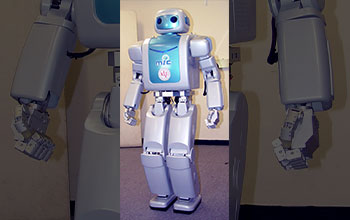Multimedia Gallery
The NBH-1 robot
The NBH-1--short for networked based humanoid--robot, a bipedal robot equipped with wireless networking capabilities that allow it to communicate remotely and receive software upgrades from external computer servers.
The robot was unveiled in March 2006 by South Korean professor Bum-Jae You and his research team from the Korea Institute of Science and Technology who claim NBH-1 is the first such android ever developed. According to You, NBH-1 has the ability to recognize people using facial recognition technology, can recognize voices and motions, and can shake hands and turn and walk (at a speed of up to 0.9 kilometers per hour) in a range of directions. It is 150 centimeters tall and weighs 67 kilograms. The team plans to upgrade the android's intelligence and movement capabilities later this year.
Although this specific research was not supported by the National Science Foundation, the agency does support similar robotics research. (Date of Image: Jan. 1, 2005)
Credit: Dr. Bum-Jae You, Korea Institute of Science and Technology
Images and other media in the National Science Foundation Multimedia Gallery are available for use in print and electronic material by NSF employees, members of the media, university staff, teachers and the general public. All media in the gallery are intended for personal, educational and nonprofit/non-commercial use only.
Images credited to the National Science Foundation, a federal agency, are in the public domain. The images were created by employees of the United States Government as part of their official duties or prepared by contractors as "works for hire" for NSF. You may freely use NSF-credited images and, at your discretion, credit NSF with a "Courtesy: National Science Foundation" notation.
Additional information about general usage can be found in Conditions.
Also Available:
Download the high-resolution JPG version of the image. (752 KB)
Use your mouse to right-click (Mac users may need to Ctrl-click) the link above and choose the option that will save the file or target to your computer.

